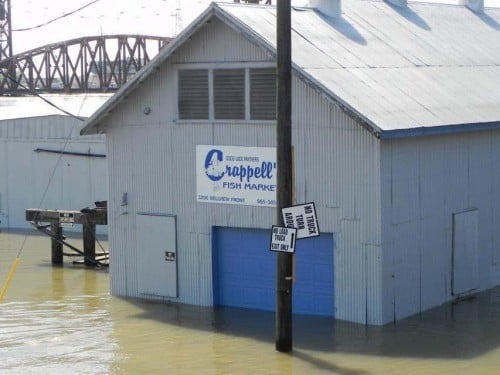Tuesday, June 7
June 7, 2011
Economic life of LA1 businesses in limbo
June 9, 2011The great flood of 2011, that indeed caused devastation in Memphis, Tenn., Vicksburg, Miss., and other locations along the Mississippi River and north of Pointe Coupee Parish, turned into nothing more than a real-life test of levee systems and flood control preparedness once water crests reached the lowlands of southeastern Louisiana.
When the U.S. Army Corps of Engineers began opening floodgate bays at the Morganza Spillway on May 14, with an intended purpose of saving the cities of Baton Rouge and New Orleans from swelling currents on the Mississippi River, flooding of the Atchafalaya Basin instead was predicted to wash out entire towns and threaten hundreds of human lives.
While evacuations upstream in Krotz Springs and Butte Larose came and went and businesses were disrupted, by the time official floodwaters reached St. Mary and Terrebonne parishes, river, bayou and lake levels seemed to be little more than an inconvenience.
When most disasters take place communities are left asking what went wrong. This time officials in St. Mary and Terrebonne parishes are reviewing what they did right.
“Everything is working in our favor right now,” St. Mary Parish President Paul Naquin said last Tuesday, when the crest level was at approximately 10.25 feet and 2 feet lower than had been predicted.
Twenty-two of 27 floodgates that follow the river through Morgan City had been closed to protect commercial and residential property in a town that, like New Orleans, battles being below sea level.
Naquin said that some businesses along the Morgan City riverfront were forced to temporarily close, but had already started making their return.
“Morgan City is losing some tax money there, but it looks like everybody is back to work,” he said. “Nobody is complaining.”
Thousands of sandbags, Hesco baskets, pumps and other tools were used in a two-week period to protect communities in St. Mary Parish. A protective levee was installed to protect Amelia and tiger tubes were used to help fight intruding waters in Franklin.
In Terrebonne Parish, 10.4 miles of new levees were constructed and another 8.2 miles of existing levees were enhanced. Approximately 2.5 miles of tubes were installed in Humphries and 560 linear feet of sheet piling was placed along La. Highway 20 to block the expected intrusion of water near Gibson.
The one project that both Naquin and Terrebonne Parish President Michel Claudet noted as being the significant factor in protecting both parishes from flooding was the constructing and sinking of a 500-foot barge complex in Bayou Chene.
“Please remember that with the elevation levels presently being experienced in Morgan City, we would have flooding if it were not for the barge in Bayou Chene,” Claudet said.
“Setting the barge in place was a challenge short of a miracle,” Naquin said. “In the real world it would take about a month to set that barge. They did it in eight days and stopped 99 percent of the flow in a high water unprotected area.”
Naquin and Claudet have already mentioned talk of constructing a permanent structure in Bayou Chene to control the flow of water currents, and protect property.
“If the Corps of Engineers doesn’t do it I know we got $19 million in [Community Development Block Grant] money,” Naquin said. Of that amount more than $2 million has been designated to repair homes damaged in past storms, then the remainder could be applied to structure construction.
“We do not have enough money to do the Bayou Chene project right now,” Naquin said. “That’s going to cost about $50 million and have a bigger pumping station than what they have in Orleans Parish. Everywhere we got a structure right now we have a plan for the future.”
According to published reports, even upstream flooding was not as devastating as anticipated. Most of the unknown amounts of water released from the Morganza Spillway flooded forest and swamplands. In St. Martin Parish water was said to have reached 35 structures, mostly out buildings. Costs for flood preparation, as well as any losses, are unknown at this time.
Claudet cautioned that although the worst appeared to be over, residents should remain vigilant until increased water levels recede. “If something should change, then we could have a major change in our parish,” he said.
“Our plan was not to lose one life or one home and I’m happy we didn’t have to test everything we did,” Naquin said.
There is no estimation on the financial cost of preparations, but according to Naquin every penny spent to protect people and property was worth the expense.
The great flood of 1927 saw the width of the Mississippi River expand to 100 miles at some areas and take a year to recede. Two hundred forty-six lives were lost and damages totaled more than $1 billion.
In 1973, a weakness developed on the Morganza Spillway and water was released into the Atchafalaya Basin causing millions of dollars in damage and displacing thousands of residents in the bayou region.
One of the differences between those events and current conditions is that the floods of 1927 and 1973 were both accompanied by months of heavy rain, while the first five months of 2011 had been unseasonably dry.
Claudet and Naquin both mentioned that engineering preparations that did not exist during previous flood events and cooperation from nature made all the difference from past flood model comparisons.
Naquin chuckled in relief as he said, “Yeah, I guess we did do something right.”
Crappell’s Fish Market, located on Bellview Front in Morgan City, was among St. Mary Parish businesses abutting the Atchafalaya River that saw water infiltrate its walls. HOWARD J. CASTAY JR.




